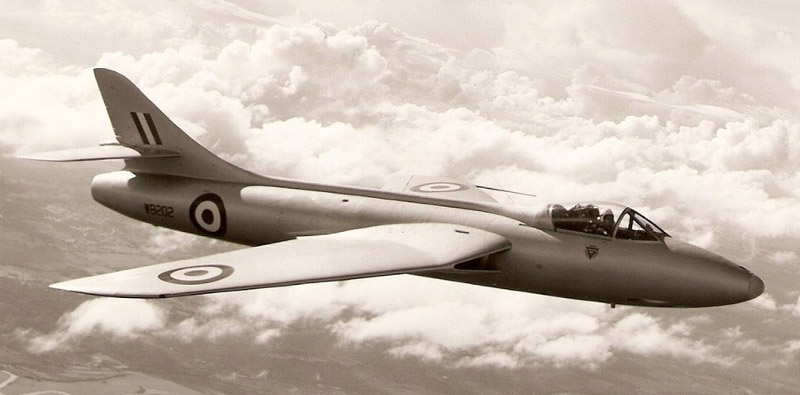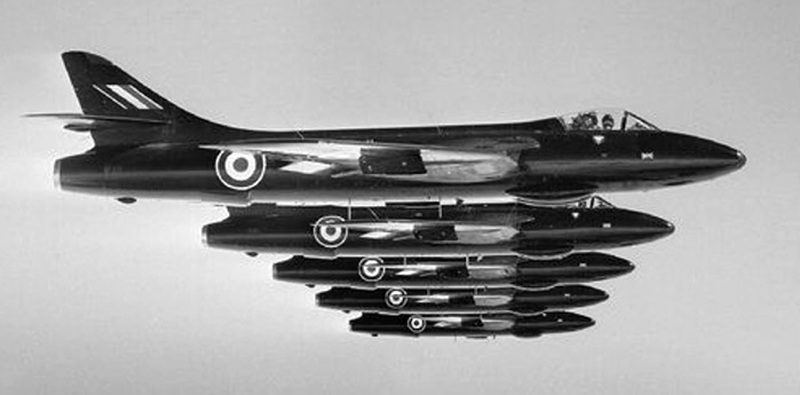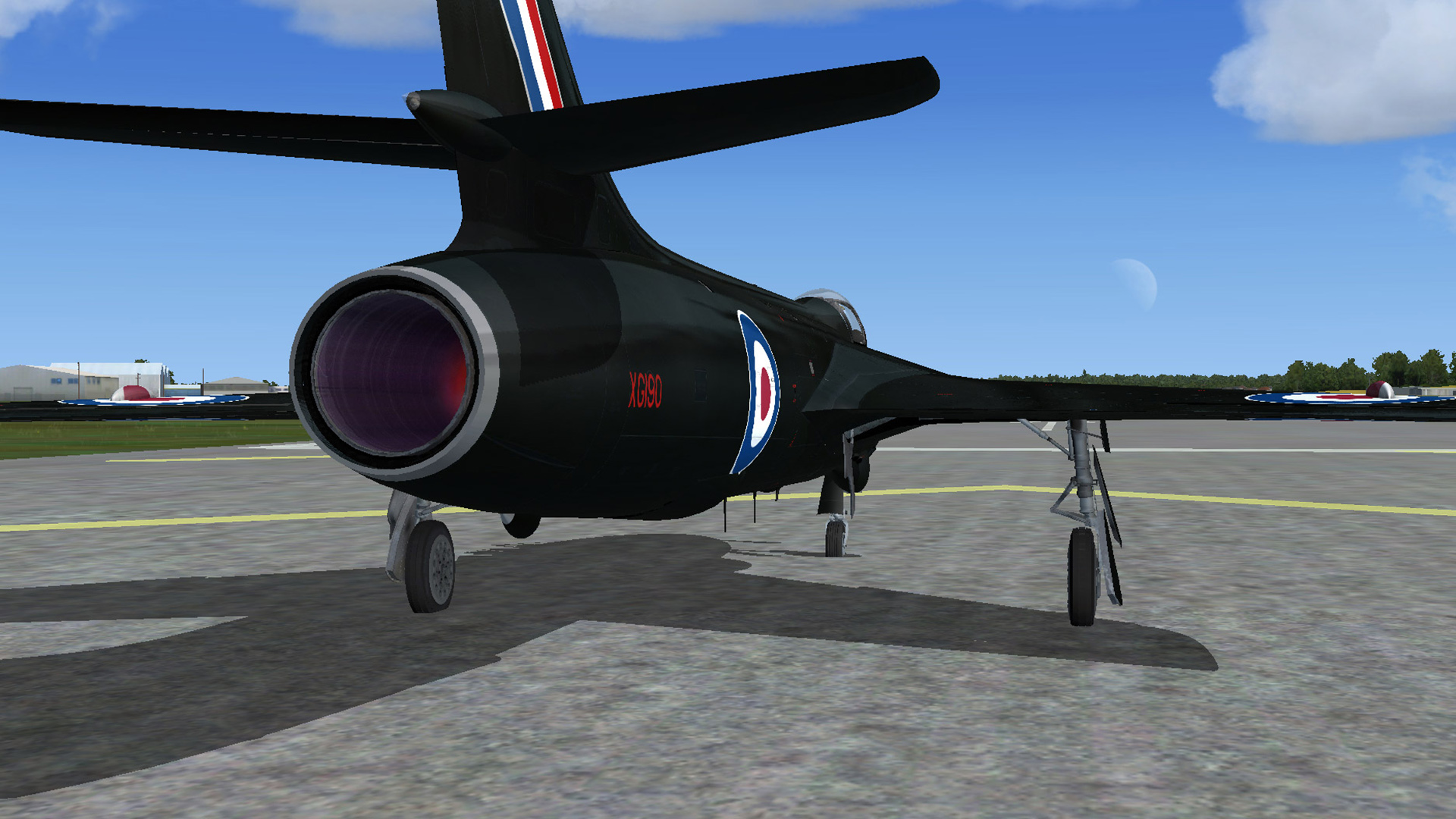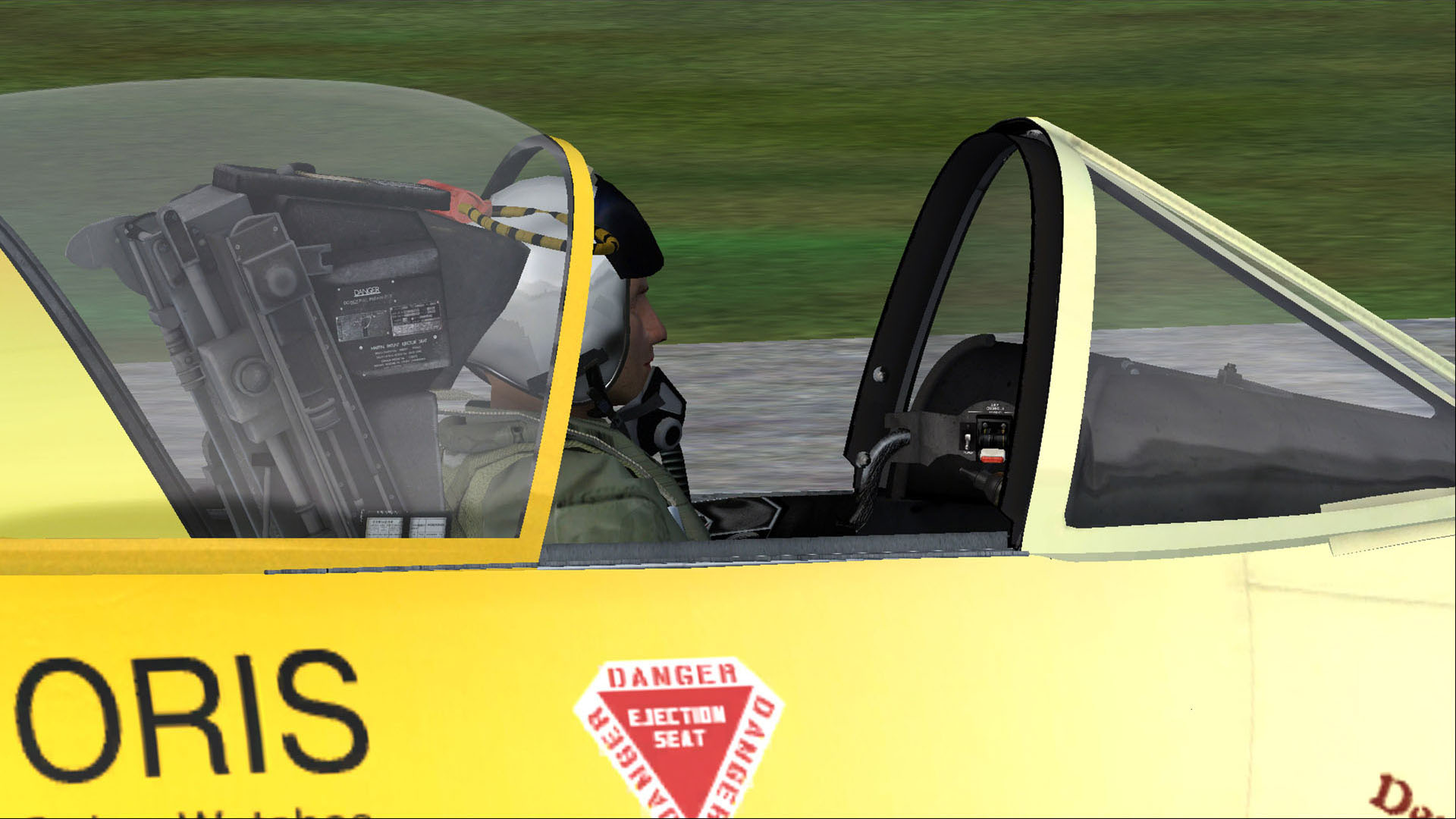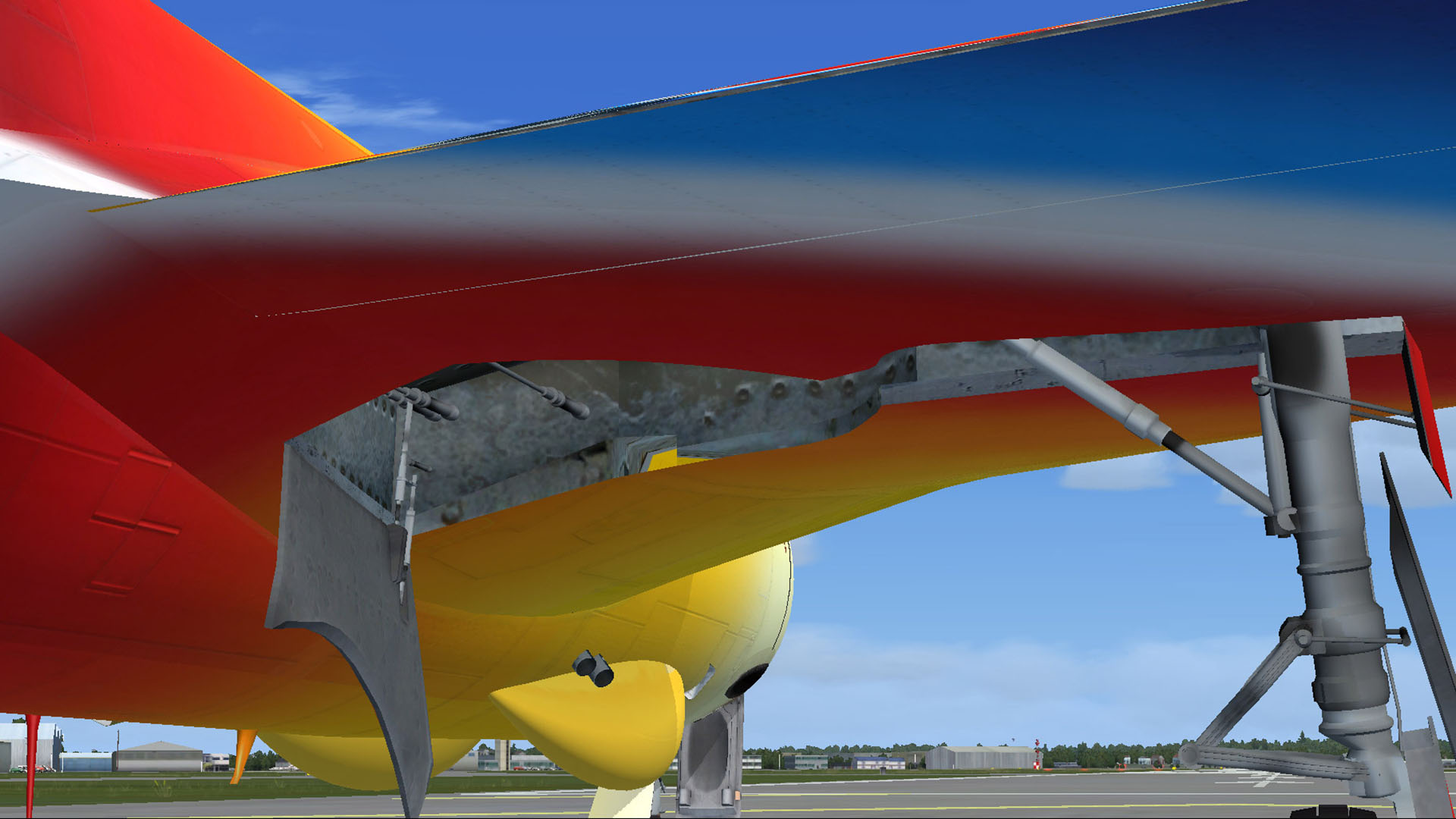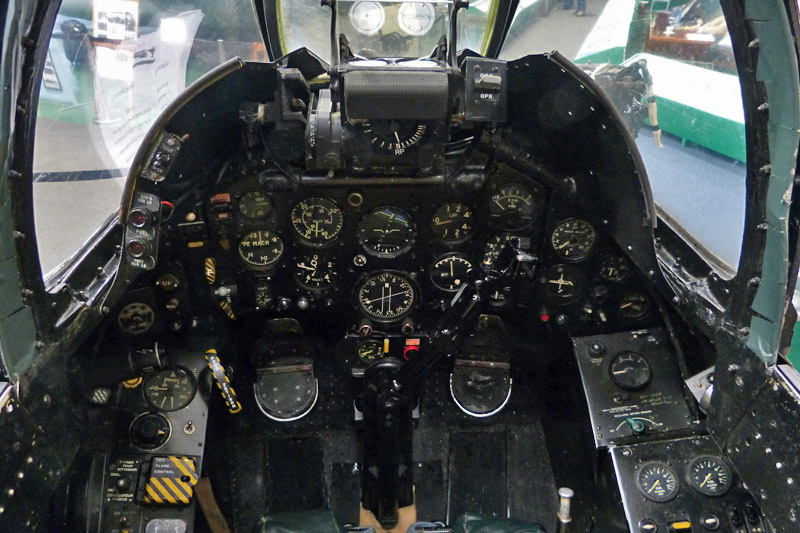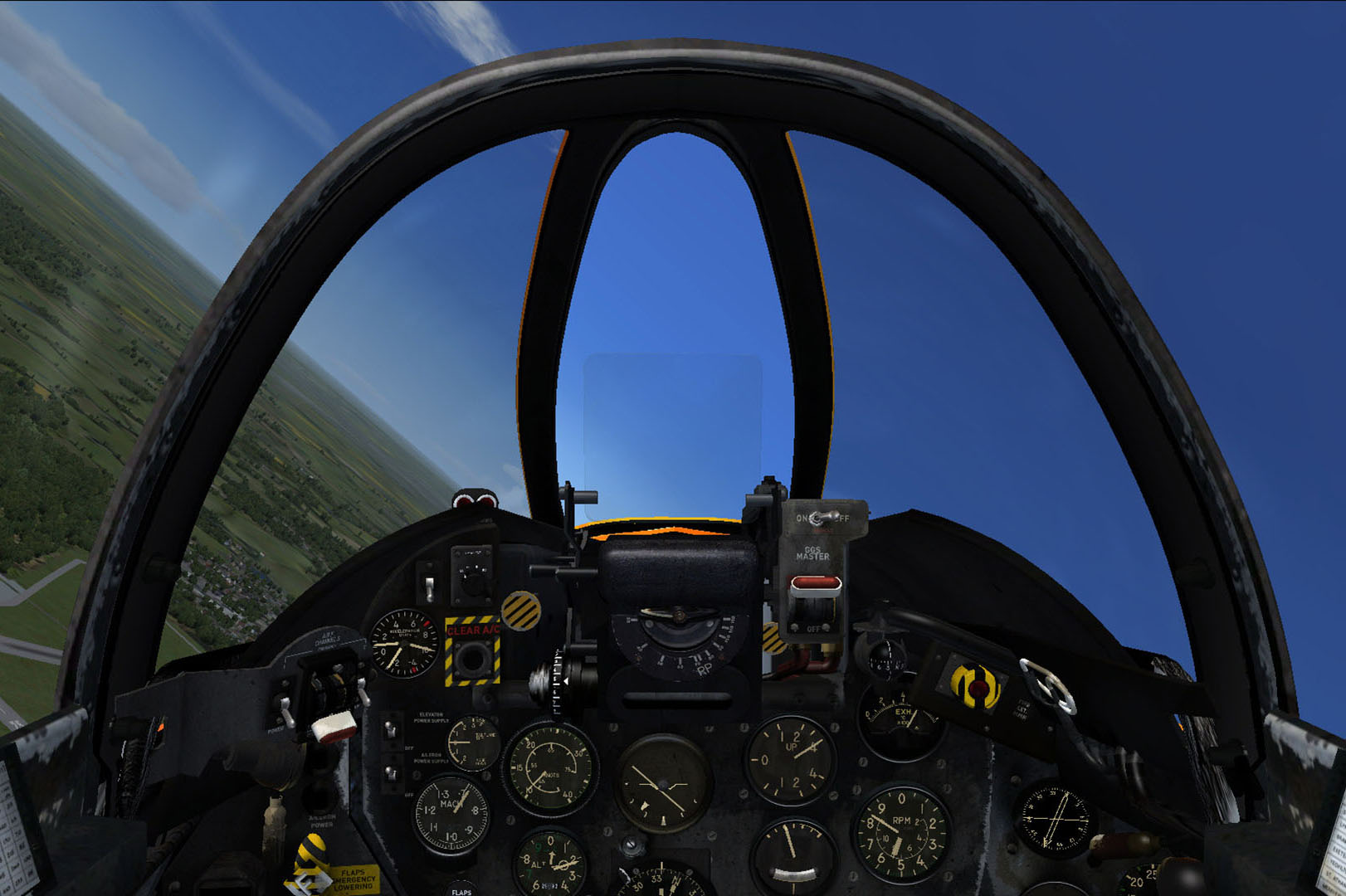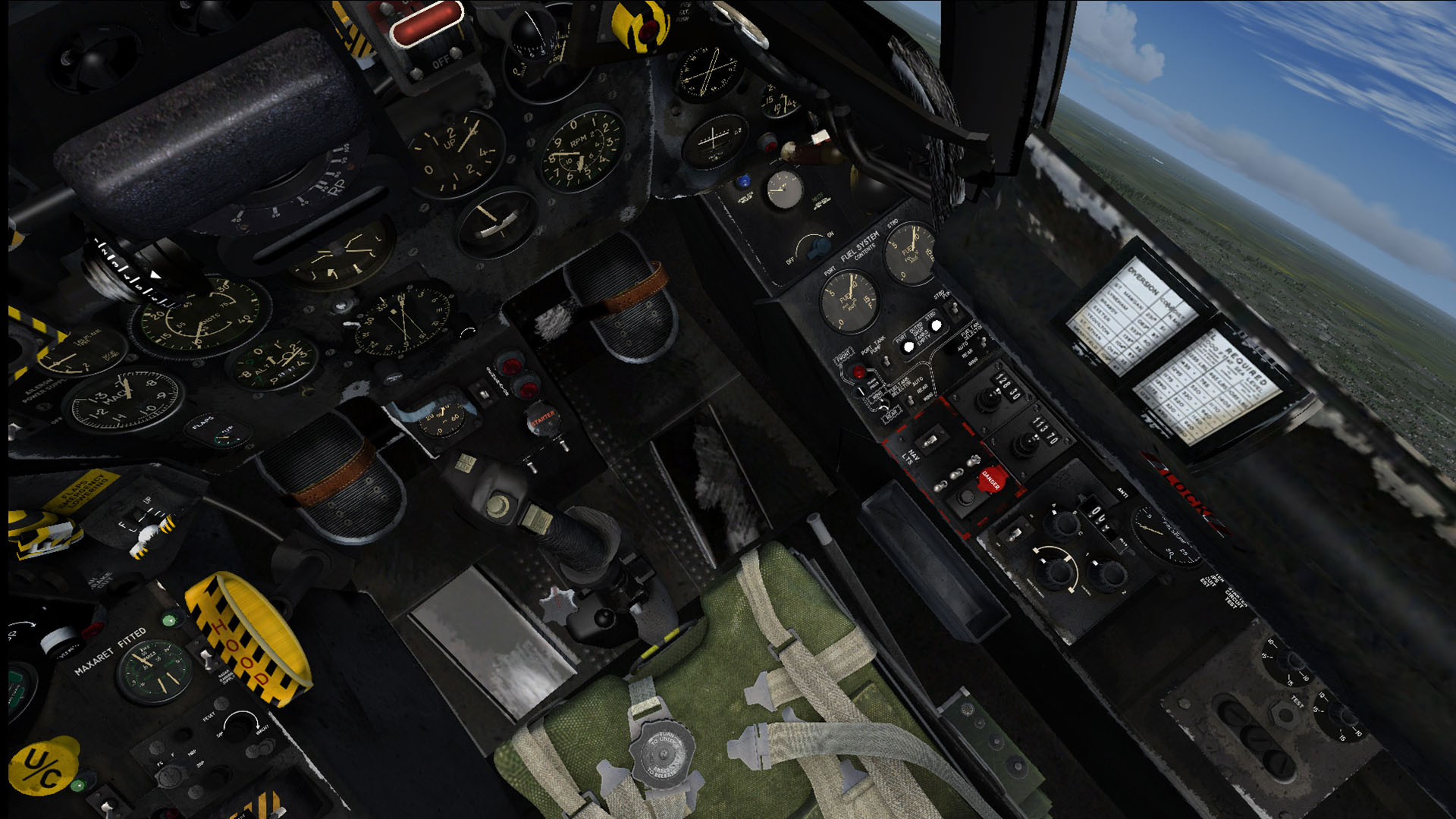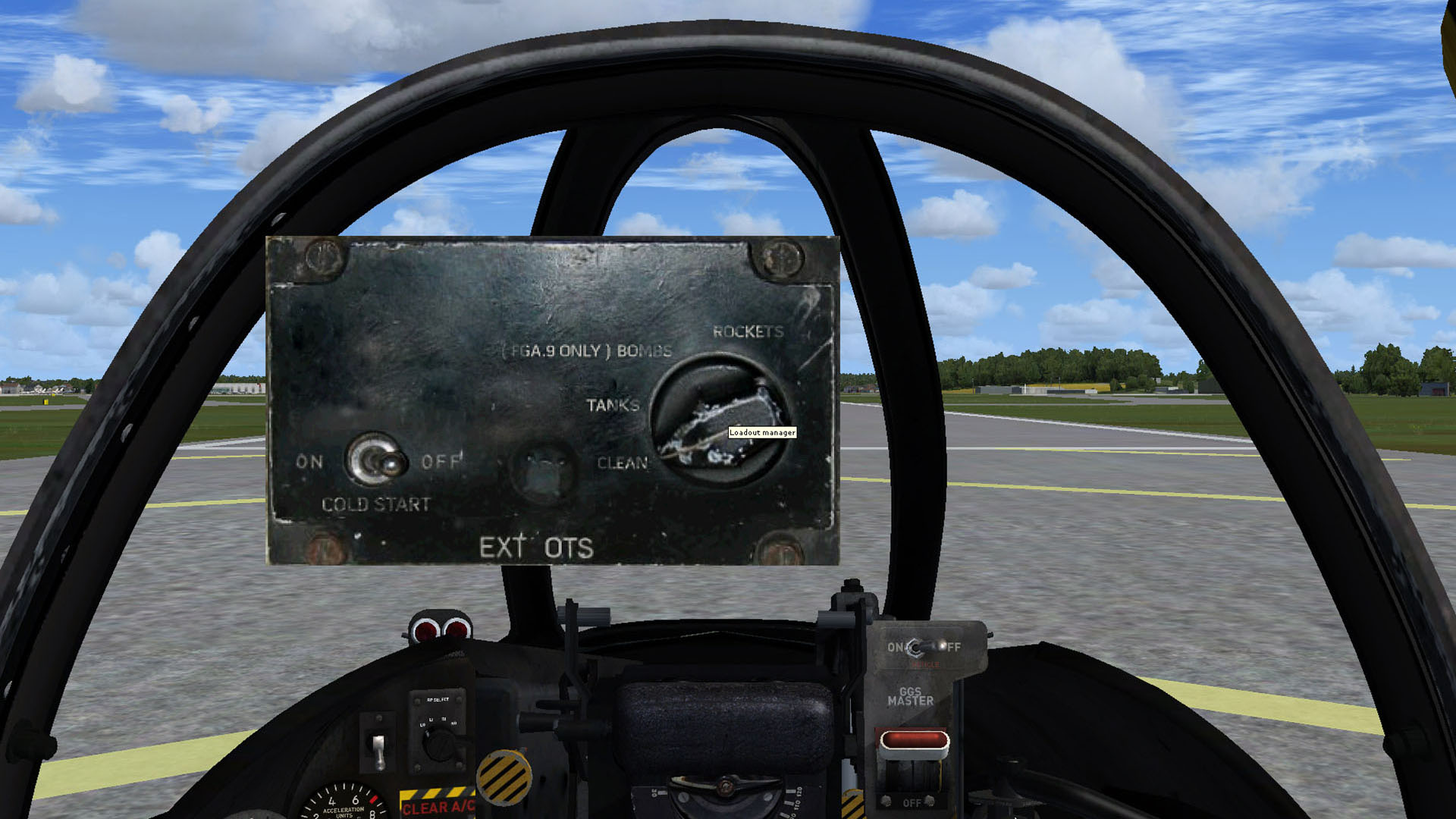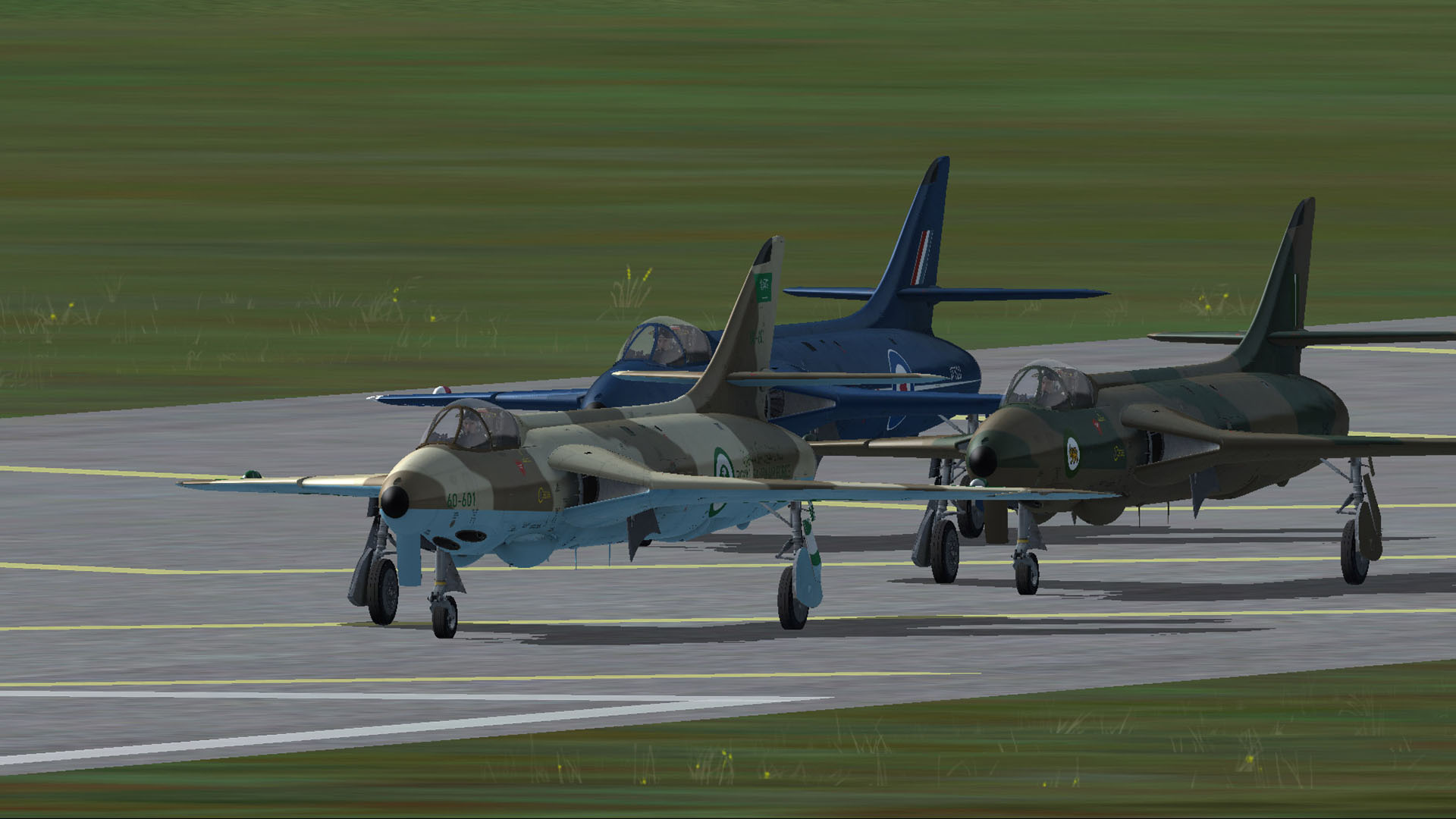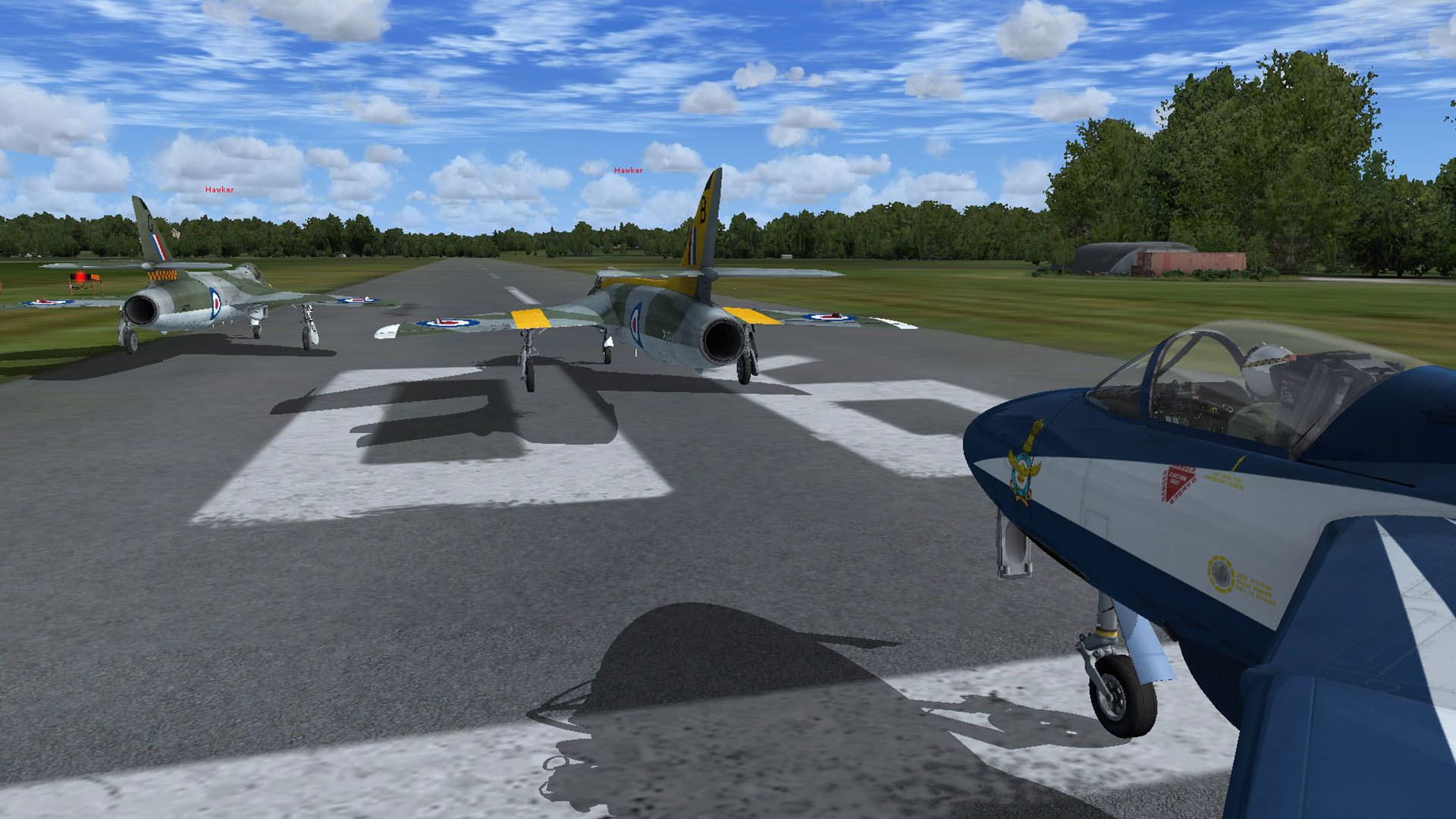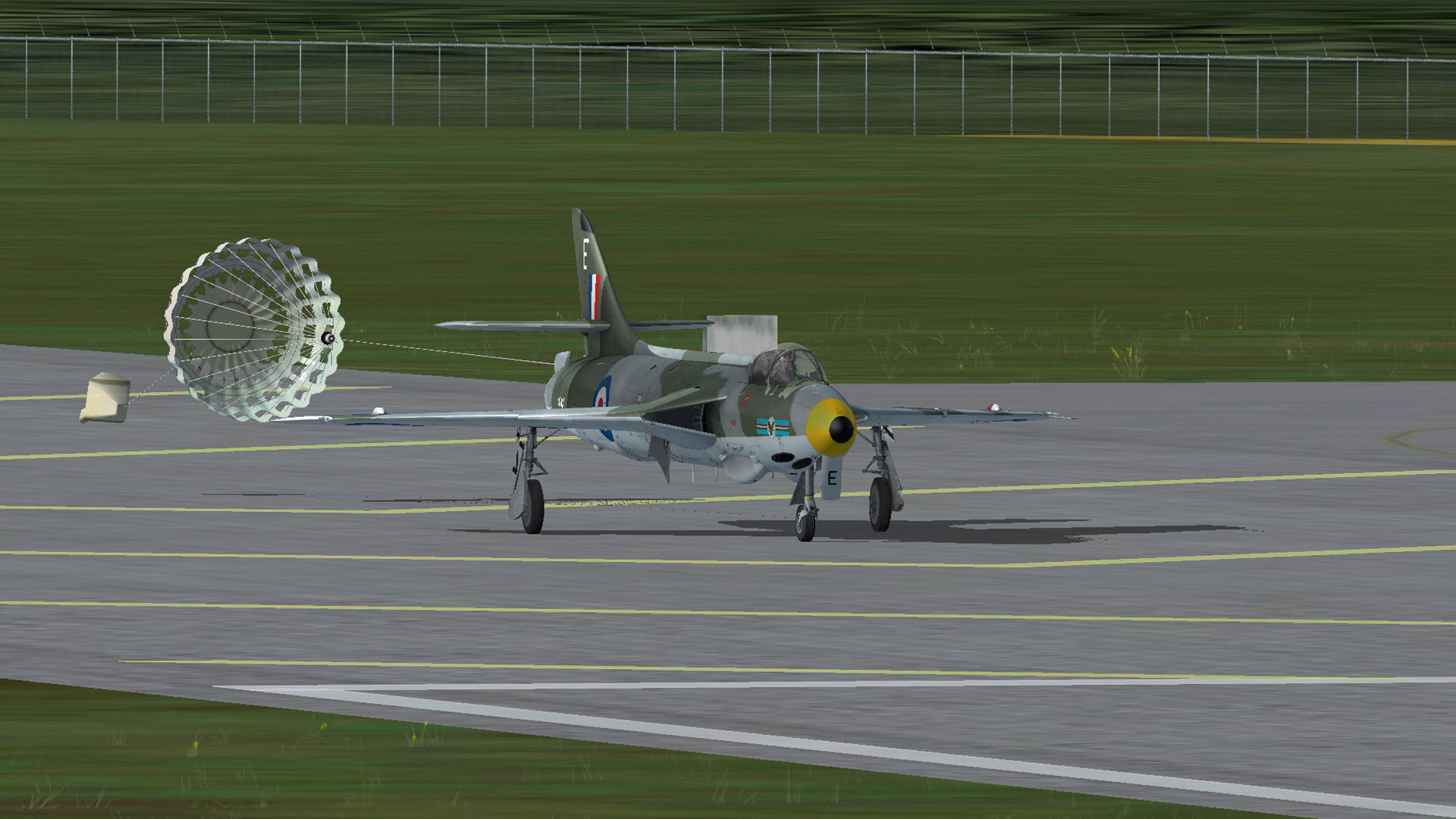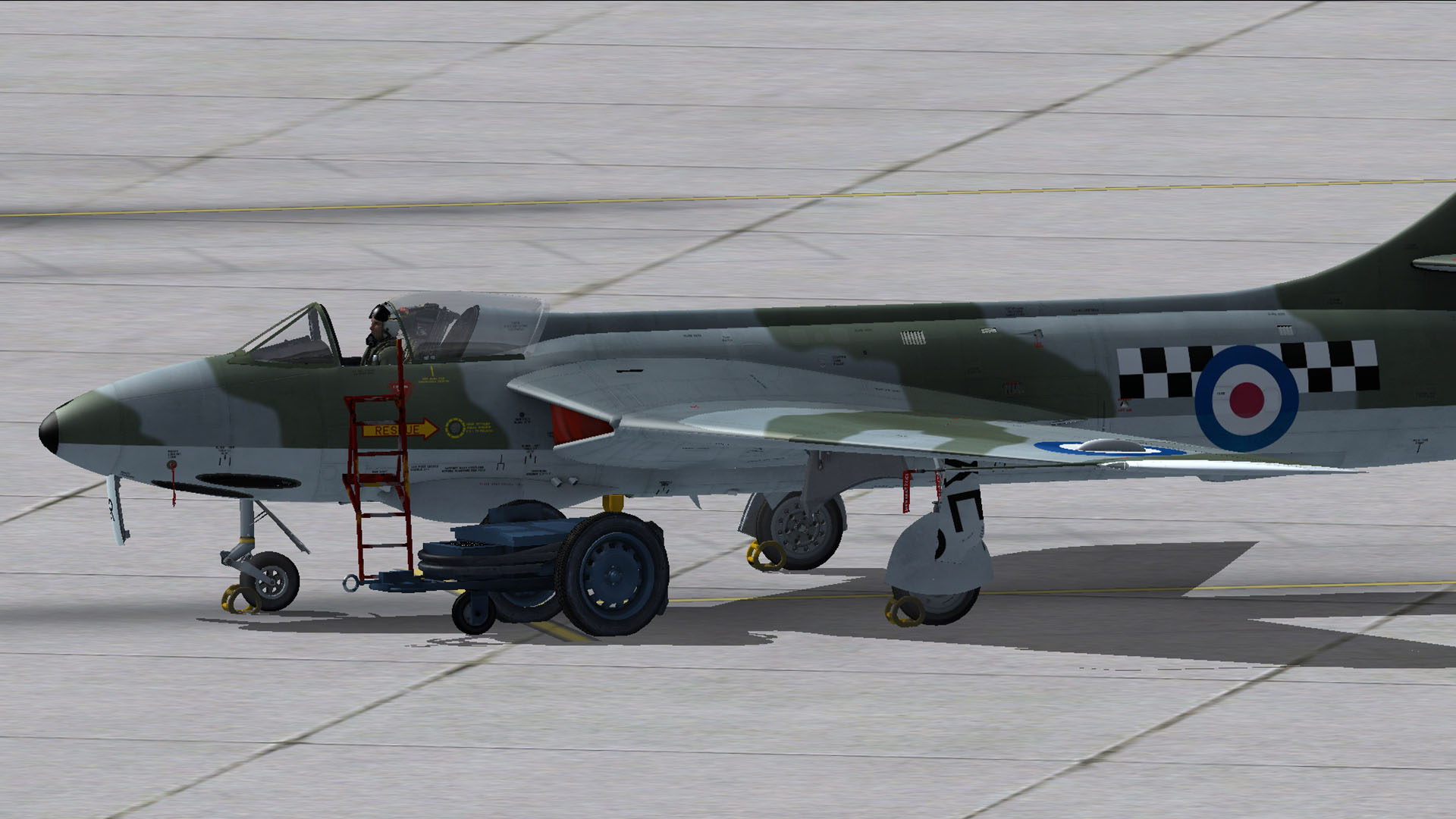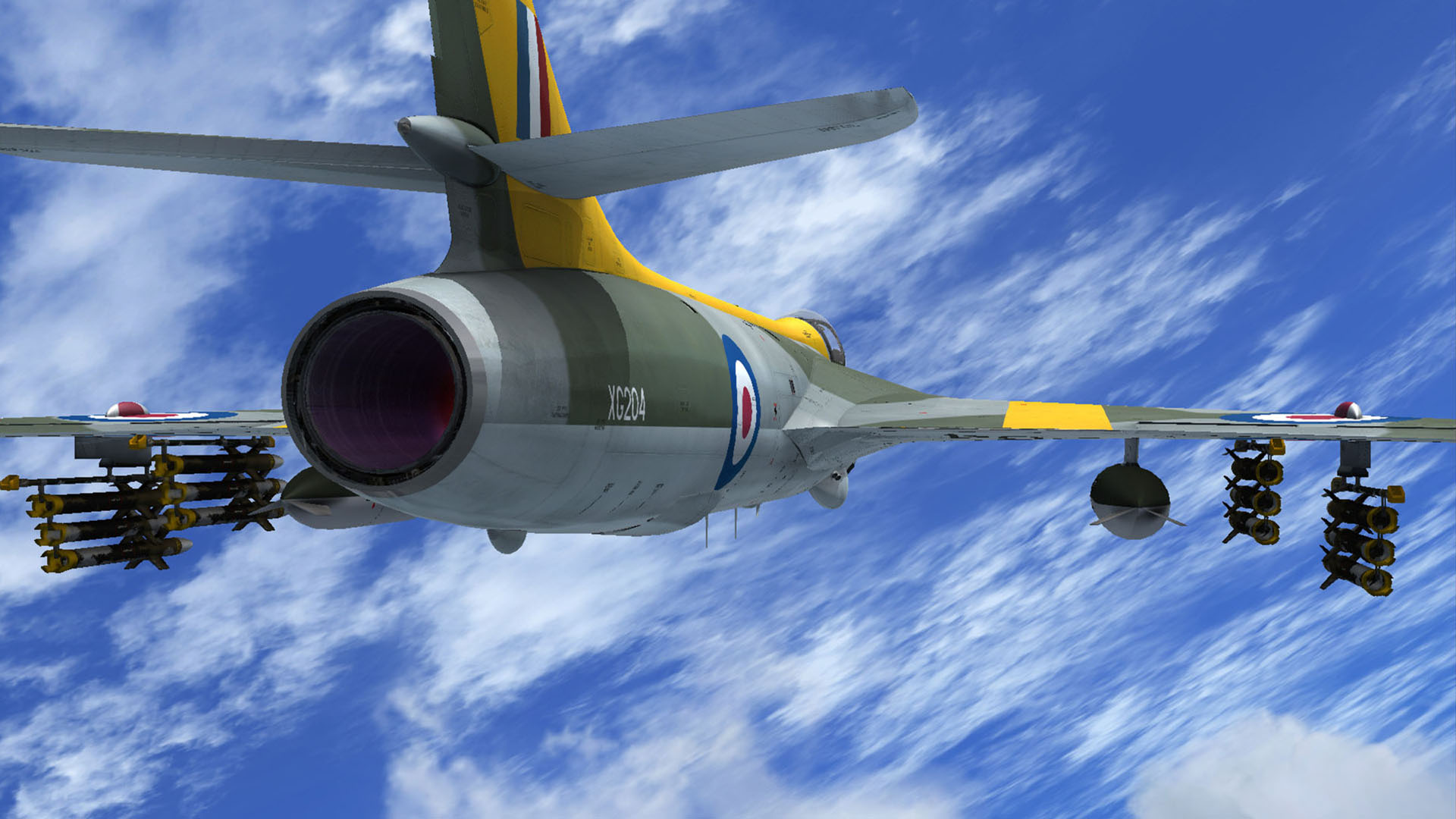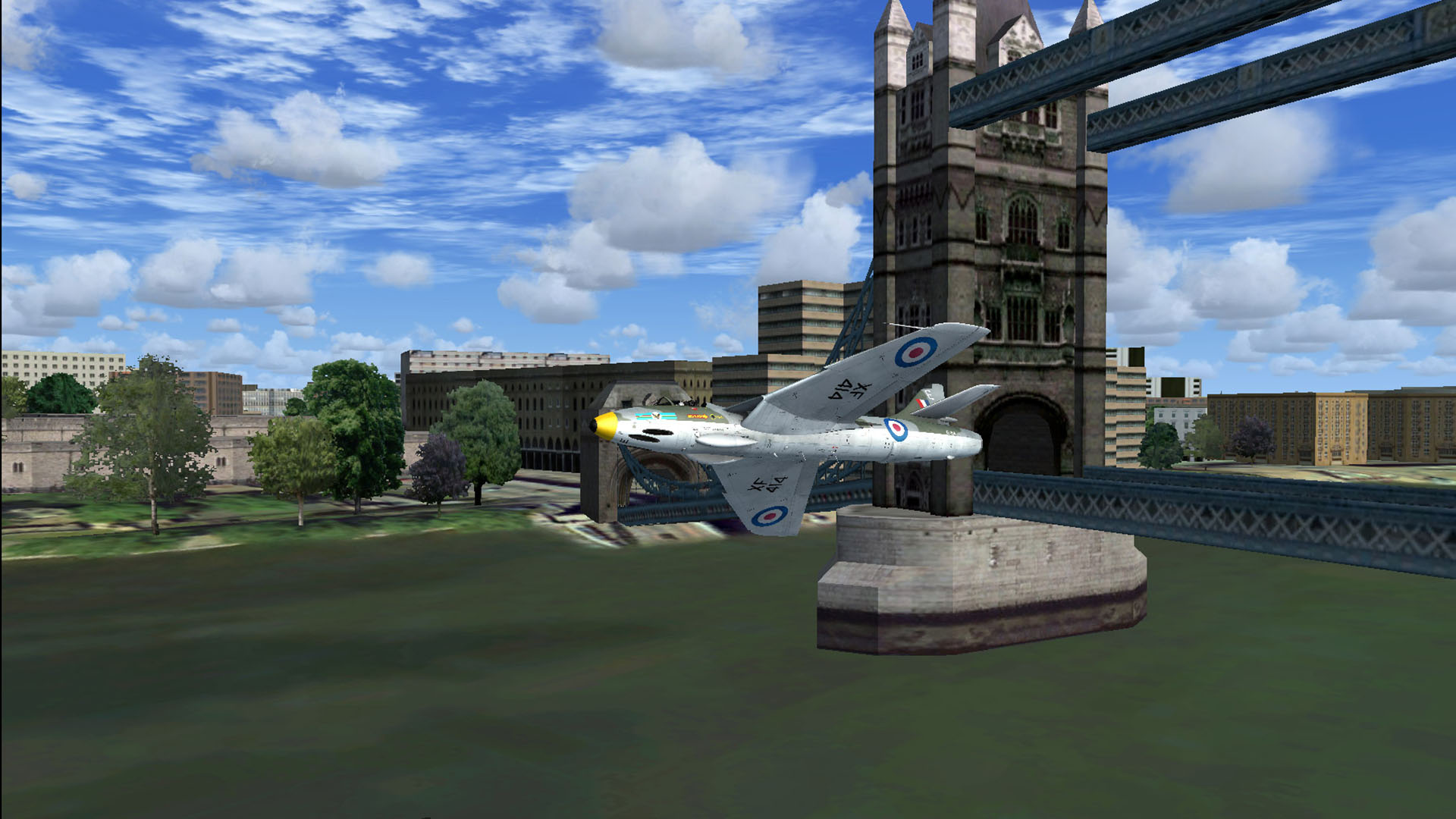Introduction
When something looks right, then it is right. A phrase often used to describe the Spitfire, and perhaps apt for that aircraft. Personally, I think it can be applied to the Hawker Hunter too, a sleek, beautiful aircraft with performance, in its day, to match. Can Just Flight's new Hawker Hunter measure up to the real thing? This review will make that judgement, but first, let's have a look at that aircraft and its impressive record.
History
At the end of World War II and the advent of the Jet engine, aircraft manufacturers were keen to produce a fast fighter to replace the RAFs Gloster Meteors. They wanted to push the boundaries of what was known about approaching the speed of sound, and the designers at Hawker came up with the single engine, swept wing Hawker Hunter.
A relatively conventional design, the P.1067 met the 1948 specifications set down by the British Ministry of Supply for a single seater day fighter with swept wings, capable of Mach 0.94 and powered by a Rolls-Royce A.J. axial-flow turbojet engine. So, the P.1067 prototype was designed and built, taking a step forward with a single jet tail pipe and with 35 degree swept back wings. The Rolls-Royce. A.J.axial-flow turbojet engine would become known as the Avon, and the P.1067 would become the Hunter.
In 1953, the Hunter broke the world air speed at Littlehampton on the south coast of England, a record that would last but three weeks, and would fall to a Supermarine Swift, an aircraft that would be out of service in 1961, many years before the Hunter. Hawker had designed a great looking aircraft which would become a global sensation and would serve with the RAF for longer than any other aircraft, and that is a record that still remains today.
The Hunter F6, as the designation hints at, was the sixth production version of the Hunter, and was first flown on 11th October 1955. It was fitted with an uprated Rolls-Royce Avon 293 turbojet engine, a revised wing with a 52 degree sweep and a "dogtooth" leading edge and with four hardpoints. This aircraft was to be capable of Mach 1.2 in level flight and so was to be a fully supersonic aircraft. 384 of these single-seat clear-weather interceptor fighter were built, and they were the most ubiquitous version.
The Hunter FGA.9 was a ground attack aircraft, all examples of which were produced from modified F6 airframes. It had a strengthened wing, could carry 230 gallon inboard drop tanks, and a drag chute. There were other alterations as well, designed to improve the aircrafts capability as a ground attack version. There were 128 of these aircraft conversions.
The Hawker Hunter saw service with both the RAF and the Royal Navy, as well as twenty two other countries armed forces. The original prototype first flew on 20th July 1951, and very many examples of the aircraft are still flying today, over 65 years later, although not with any armed forces. The last military operated Hawker Hunters were retired from active service in the Swiss Airforce in 2016. Some Hunters remain in service as target towing aircraft etc. with various organisations such as the Airborne Tactical Advantage Company in the USA. ATAC operates Mk-58 Hawker Hunters on military tactical training roles for the U. S. Navy, Air Force and Air National Guard.
The Hunter was sold widely across the globe. The 22 countries which have operated Hunters purchased them directly from Hawkers, or indirectly from aircraft leaving the service of other nations. With about 60 different home and export marks and about 2000 airframes built, the Hunter has been and continues to be a much loved aircraft all over the world.
The F.6 main armament was four nose mounted 30mm Aden Cannons with side pods to collect the empty shell cases prevent them from becoming ingested into the engine. These were nicknamed "Sabrinas" after a popular and well-endowed glamour model of the time. The FGA.9 could also carry under wing bombs and rockets.
Availability and Installation
The Just Flight's Hawker Hunter is currently available from Just Flight as a download only product. It is priced at £24.99, or the equivalent on currency cross rates. The installation process requires you to log in to your Just Flight account to verify the product and then the installation process is intuitive and seamless. The single downloaded file allows you to install this model into Flight Simulator X (Acceleration, Gold or SP2 required), FSX: Steam Edition or P3D v3/v2/v1.
There is a professional quality paint kit available for download from Just Flights web site, its zip file is 331MB in size, and is a collection of layered PDF images which allows for the repaint of the Hunters airframe, its droppable objects, and its canopy. I can see that this will be very useful given the Hunters wide international use.
Model Features
The Just Flight Hunter features both the F.6 and the FGA.9 variants in great detail with multiple animations including but not limited to:
The correct landing gear sequence;True to life flap actions;
Accurate airbrake functions;
Realistic canopy movements;
Realistic animated pilot;
Detailed engine fan is visible through the intake mouths;
Flap recess and gear well detail;
Boarding steps, wheel chocks, and pre-flight flags;
Ground Power Unit; and
13 liveries covering British and overseas air forces.
Configuration Panels
Outside the installed Hunter and FSX, there is a small utility which allows the user to choose between realistic castor nose wheel with differential breaking as steering, or a steerable nose wheel. Inside the sim, there are switches which allow you to change various aspects of the aircraft. There is a ground power switch which, when turned on, causes the battery cart to appear and allows the aircraft to be started with external power, there is a switch to show or hide the pilot and a third switch to show or hide the chocks, tapes and engine covers.
Visual Appearance
The F.6 was designed as fighter/interceptor and entered RAF service in that role. The FGA.9's were not made from scratch but were all converted F.6 aircraft. The external differences are minimal, however, noticeable on the FGA.9's tail pipe, there is a pod and fairing over the top of the rearmost section of the tail pipe. This houses a braking parachute that is deployed on landing to slow down the aircraft. The F.6 and other F.6 derivatives had no such fairing or pod.
The Hunter's tail pipe is relatively long, and there is no afterburner. The glow of the engine is deep within the fuselage, and is an effect that is well modelled on this model. The FGA.9's parachute pod is animated, and the deployment of its breaking parachute is reproduced well.
Having displayed the tail differences between the F.6 and the FGA.9 above, note the detail on both the external, and internal tetures on the aircraft. This is typical of the attention that has been paid to the rendering of the aircraft. The level of detail is just as good on the Black Arrows aircraft, however its sleek glossy black finish makes it harder to pick out in the screen shot.
You can see from the picture above, and from the screenshot in the animations and special effects section of this review, the breaking parachute deployment is very well modelled, and even includes the drogue chute behind the main parachute. Below is a close up of the pilot and cockpit. Note the superb detail on the ejector seat.
More detail is hidden in the depths of the aircraft, when engine isn't running, the detail of the compressor fan is visible. When the engine is running, the blades appear to turn and blur. In fact, there is detail wherever you look, the inside of the undercarriage wells are well detailed, as are vents, hydraulics, and riveting.
Internal Model
Try to find the definitive Hunter cockpit, and I guarantee that you won't be able to. Hunters were in service so long that cockpits were tinkered with, added to, rearranged and personalised to such an extent that after that all that time in service, you would be hard pressed to find two alike.
Below left is a typical "real life" cockpit, and below right is that of the Hunter F.6 from the flight sim model. As you can see from the screenshots below, there is a very strong correlation between the two. I am happy that the Just Flight Hunter is a highly accurate reproduction of the real cockpit.
The cockpit is well presented with very fine detail on every aspect. Most, but not all, switches work, both in terms of actual switch function, and the systems they operate. I have a couple of niggles with the switches - I couldn't get the flaps switch to work with my mouse no matter how I tried. However, it correctly mirrored an action from keyboard or from a mapped command to joystick button perfectly, so the issue was with the switch operation via mouse click. Also, I had a problem with the switch that removes the pilot. This worked intermittently, sometimes it would remove the pilot but most times it didn't work. Another issue I had was with the air brakes, again the switch didn't appear to work. However, this issue was different, as although clicking on the switch bought no animated response and no change in the tool tip which constantly read "Air Brake (shut)", despite this appearance of inaction, the air brake did deploy. Having no change in the switch position, or the fact that the tool tip gave no reliable information on the true air brake status, was not helpful at all.
Realistic dependencies exist within the switched functions, as an example, the start button cannot be used until its guard us flipped up. There is also a choice of cockpit lighting, normal panel lighting and green UV lighting, which provides a softer greenish light to the cockpit, less intrusive than standard lighting.
A 2D popup panel is supplied for payload selection. The choice of clean, external tanks, bombs (FGA.9 only), and rockets is selectable via a rotary switch, and there is also a simple switch which enables the choice between a cold & dark or a ready to fly. The 2D popup selector panel is styled in the same way as the main cockpit and is a great way to implement this sort of thing, but would be better if it were also accessible from the cockpit in the same way as, say, the show/hide pilot switch, but is, instead, available from the menu bar.
Models and Liveries
There are two basic models included in this package, the F.6 and the FGA.9. The F.6 was built for the RAF, but was sold overseas with slightly different specifications as requested by the customer under different marks. Some examples are: the Indian Air Force bought 160 Mk.56 aircraft, essentially F.6 aircraft but with a slightly different Indian specification. The Swiss Air Force bought 100 Mk.58 aircraft, all based around the RAF's F.6 aircraft, 12 of which were actually conversions from ex-RAF F.6 aircraft. The Royal Saudi Air Force purchased four F.60 aircraft that were all converted F.6 aircraft.
The FGA.9 was initially built for the RAF, converting existing RAF F.6 airframes. India purchased a few FGA.56A aircraft, which were converted FGA.9 aircraft changed to meet Indian specifications. All of these marks are included with this add on.
The F.6 comes in six liveries, all bar one are RAF, the exception being an aircraft in Royal Netherlands Air Force colours. There is an F.56 Indian aircraft, two F.58 aircraft, one in Swiss colours (above) and the other in the privately owned, G-PSSD "Miss Demeanour" (above), and an F.60 Saudi aircraft. There are two RAF liveries for the FGA.9, and one FGA.9 in Rhodesian Air Force colours.
There is something for everyone in the set of liveries provided, both civil and military, RAF marks and for overseas variations.
Animations and special effects
The Hunter has all the animations you would expect from a high end product, realistic undercarriage movement, with animation that correctly mirrors the opening and closing sequencing of the individual wheels. The braking parachute is well implemented, and comes complete with opening pod doors and drogue chute. All the usual animated control surfaces are included, and many others besides.
Sounds
The sound set is very good indeed. Details abound, and include the characteristic loud thump as the nose wheel locks closed. A fantastic engine start sequence with clearly audible engine igniters, and a loud buffeting sound audible as a stall approaches. Also, there is that signature Hunter howl, caused by the airstream across the gun ports as particular speeds. Advancing the throttle at first produces little change in engine note, it takes time to spool this engine up, but it comes, and after that so realistic lag present in early jet engines, the engine note starts, whine and then roar. All in all, a comprehensive and convincing sound set.
General Characteristics and Performance
So, what is it like to fly? I always set up my aircraft in the flight sim to be as realistic as possible and so it was in this condition that I started my testing. I tested the aircraft in a "clean" condition as this is the most easily measurable configuration.
The engine start sequence is good, with the igniters firing and the surge at the engine lights up, taxi was good with a careful balance of throttle and differential braking, then engine takes a while to respond to throttle commands as did the real Rolls Royce Nene, so good taxi speed is best found with patience as over cooking the throttle will result in a surge-brake style which wouldn't do in front of the CO.
Brakes on at the runway end, and with the throttle at maximum, wait for the engine to spool up, it takes a few seconds, and when the power is fully on, the nose dips against the brakes, release the brakes, and start the take-off run. The aircraft will take to the air at about 145 kts, and the undercarriage will need to be up at 250 kts to avoid damage. I found that at full throttle as speed increased, there was a tendency for the nose to pitch up after take-off, and so closing the throttle was advisable once unstuck. If allowed itto continue, the upward pitch of the nose would result in a flat stall and still being low the end of your flight. This tendency was an issue in some Hunter versions.
Once stabilised in normal flight, flying the Hunter is easy with gentle control movements required for normal flying. There is plenty of room on the controls for combat flying if you want to throw the aircraft around the sky. However, be careful not to be too brutal or you may put the aircraft into its high speed stall. The stall is forewarned by a loud buffeting sound, and once in a stall I found recovery to be fairly simple, but height loss during recovery was reasonably large. She will travel at over 600 kts when low but best cruise is about 480 kts. The Hunter will go through the sound barrier and reach Mach 1.0 in a shallow dive, so I tested this and found that it did, but it needed a long but shallow full power dive to do so.
Flaps are required for landing only, however the air brake and throttle should be used in the first instance to reduce speed, followed by 35 degrees of flaps. At 250 kts, the undercarriage should be lowered, but be aware that this will cause the air brake to go in automatically. Reduce speed to 160 kts and the full flaps should be applied, with touchdown speed being 130 kts. Then it's a case of throttle off and parachute and/or brakes depending on the mark of aircraft flown. She is a fairly easy aircraft to fly.
Documentation
The Just Flight Hawker Hunter has a single 30 page manual, there is an introduction to the aircraft and its history, but most of the manual is focused on the purchased product rather than the real aircraft. I seem to say this in all my reviews, and I say it again, Just Flight's documentation is second to none in my opinion. At no point does the manual lapse into a reproduction of a real-world manual, as so many add-on producers seem to do. The manual covers an introduction to the Hunter, notes on installation, a full guide to all of the aircraft's panels and systems, notes on flying the Hunter, and a full set of procedures from pre-flight cockpit checks, through to a shutdown procedures guide. The manual is comprehensive, and contains all you need to know to get the best from the product without having to wade through a load of excess material which is of casual interest. If you want a huge amount of information on the real aircraft, buy a book.
To get the most from the Hunter it is worth spending 15 minutes or so reading the manual from cover to cover. It does a good job of describing the install and uninstall processes and has a step by step guide to the instrumentation, procedures, and the little things that add authenticity to the aircraft, like access the ground external power source etc. This is followed by a how to fly section and then a set of checklists. All good reference material.
Value for Money
The Just Flight hawker Hunter is very reasonably priced at £24.99. It is by no means Just Flight's most expensive product, which makes it even more worth the money. This add-on was pure joy to fly and I was impressed by the simplicity of the methods of configuration. It is great to fly and allows you to fly in different configurations, some setups for what would be high level missions, others for low level work, and a good few other possibilities as well. I have no hesitation in endorsing the price as good value for money.
Simulator Performance
I tested the Just Flight Hawker Hunter on a high-end PC. It performed very well throughout my review flying and had no sign of any frame rate slowdown whatsoever when encountering complex scenery. Performance was excellent at all times, and I cannot fault this add-on in this respect.
Virtual Reality
This is my first review that contains an evaluation of an aircraft in terms of its use with VR. I spent some time flying this aircraft with an Oculus Rift VR set, looking at some specific aspects that would be of interest when using a VR headset.
Will this add-on actually work in a VR environment? I am pleased to say it does, once settled into the seat, you get a sense of the cramped conditions a pilot was faced with in the Hunter cockpit, all switches dial and levers had useful hints pop up as the mouse cursor rolled over them, and all the control labelling was clear.
Flying the Hunter in VR was easy, apart from the switch issues that I mentioned earlier, it is hard to feel around for a mapped switch if the cockpit one is not functioning properly. Apart from that, it was easy to fly the aircraft using the virtual cockpit instrumentation and controls. In VR it is always a good idea to map the throttle, joystick, wheel brakes and rudder to hardware, but then the rest of the controls of the aircraft should be available from within the cockpit. The Hunter allowed this to be done easily. The only thing that was not readily available from the VR cockpit was the load out controls popup panel, as this has to be accessed from the view menu which is not easy to get to whilst in VR. Pilot show/hide, tapes, chocks and ground equipment toggles are all controllable directly from the cockpit and so presented no problem other than the switch issues outlined before.
The Just flight Hunter is a worthy addition to anyone's VR flight simulator stable.
Technical Requirements
This Just Flight Hawker Hunter's specified technical requirements are as follows:
Flight Simulator X (Acceleration, Gold or SP2 required), FSX: Steam Edition or P3D v3/v2/v1;2.5GHz or any Dual Core;
2.0GB RAM;
512MB graphics card;
Windows 10 / 8 / 7 / Vista / XP; and
825MB hard drive space.
Review Computer Specifications
The specifications of the computer on which the review was conducted are as follows:
Intel i7 6700K Skylake 4.00GHz overclocked to 4.6GHz;NVidia GTX970, 4GB;
16GB, DDR4, 2133MHz;
Windows 7, (64bit);
Lockheed Martin Prepar3d Flight Simulator v3 and;
Microsoft Flight Simulator FSX Acceleration.
Verdict and Scores
Verdict
| The Just Flight Hawker Hunter F.6 & FGA.9 is great value for money, even though there a few gremlins in the cockpit. No doubt these will be fixed by the developer in due course. The Hunter is a lovely addition and yes, it's yet another winner from Just Flight. |
Scores
For |
Against |
Category |
Score |
|---|---|---|---|
| Highly detailed and quality textures | Cockpit switches issues | External Model | 9.5 |
| Multi configurable | No direct access to load-out panel from cockpit | Internal Model | 9.0 |
| Thorough documentation | Sounds | 10 | |
| Fantastic value for money | Flight Characteristics (does it fly by the numbers) | 10 | |
| Serious and fun liveries | Flight Dynamics (does it feel like what it looks like) | 10 | |
| Documentation | 10 | ||
| Value for Money | 10 |
Overall Score
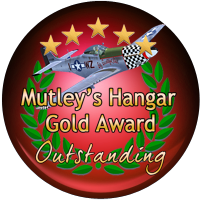
The Just Flight Hawker Hunter is awarded an overall Mutley's Hangar score of 9.8/10,
|


